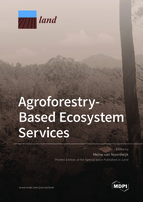Agroforestry-Based Ecosystem Services
A special issue of Land (ISSN 2073-445X).
Deadline for manuscript submissions: closed (30 October 2020) | Viewed by 127908
Special Issue Editor
2. Centre for International Forestry Research and World Agroforestry (CIFOR-ICRAF), Bogor 16155, Indonesia
3. Plant Production Systems, Wageningen University and Research, 6700 AK Wageningen, The Netherlands
Interests: agroforestry; ecosystem services; landscape; water
Special Issue Information
Dear Colleagues,
The Sustainable Development Goals have called attention to the need for the multifunctionality of landscapes that simultaneously contribute to multiple goals. In the UN decade of landscape restoration, as well as in response to the climate change urgency and biodiversity extinction crisis, an increase in global tree cover is widely seen as desirable, but its management by farmers and/or forest managers remains contested. As a dynamic interface between agriculture and forestry, agroforestry has only recently been formally recognized as a relevant part of land use (with ‘trees outside forest’) in important parts of the world—but not everywhere yet. Agroforestry research relates tree–soil–crop–livestock interactions at the plot level with landscape-level analysis of social-ecological systems and efforts to transcend the historical dichotomy between forest and agriculture as separate policy domains. An ‘ecosystem services’ perspective quantifies land productivity, flows of water, net greenhouse gas emissions, and/or biodiversity conservation and combines an ‘actor’ perspective (farmer, landscape manager) with that of ‘downstream’ stakeholders (in the same watershed, ecologically conscious consumers elsewhere, global citizens) and higher-level regulators designing land use policies and spatial zoning. Several voluntary, performance-based economic incentive mechanisms (including payments for ecosystem services, co-investment in environmental stewardship, social-ecological certification) have emerged and have been subject to action-research-based learning. A synthesis across the plot, landscape, and policy level 'theories of change' is expected to reveal further opportunities to strengthen the cross-scale linkages.
For this Special Issue, we invite case studies or synthesis papers that achieve the following:
1) Quantify change in ecosystem services in forest–agriculture interface landscapes and relate such to stakeholder concerns and farmer/manager decisions;
2) Analyze efforts to increase the feedback from external stakeholders to land use decisions (including ‘agroforestry’) within landscapes; and/or
3) Describe and analyze efforts to transcend an existing forestry versus agriculture dichotomy in land use policies.
Prof. Dr. Meine van Noordwijk
Guest Editor
Manuscript Submission Information
Manuscripts should be submitted online at www.mdpi.com by registering and logging in to this website. Once you are registered, click here to go to the submission form. Manuscripts can be submitted until the deadline. All submissions that pass pre-check are peer-reviewed. Accepted papers will be published continuously in the journal (as soon as accepted) and will be listed together on the special issue website. Research articles, review articles as well as short communications are invited. For planned papers, a title and short abstract (about 100 words) can be sent to the Editorial Office for announcement on this website.
Submitted manuscripts should not have been published previously, nor be under consideration for publication elsewhere (except conference proceedings papers). All manuscripts are thoroughly refereed through a single-blind peer-review process. A guide for authors and other relevant information for submission of manuscripts is available on the Instructions for Authors page. Land is an international peer-reviewed open access monthly journal published by MDPI.
Please visit the Instructions for Authors page before submitting a manuscript. The Article Processing Charge (APC) for publication in this open access journal is 2600 CHF (Swiss Francs). Submitted papers should be well formatted and use good English. Authors may use MDPI's English editing service prior to publication or during author revisions.






